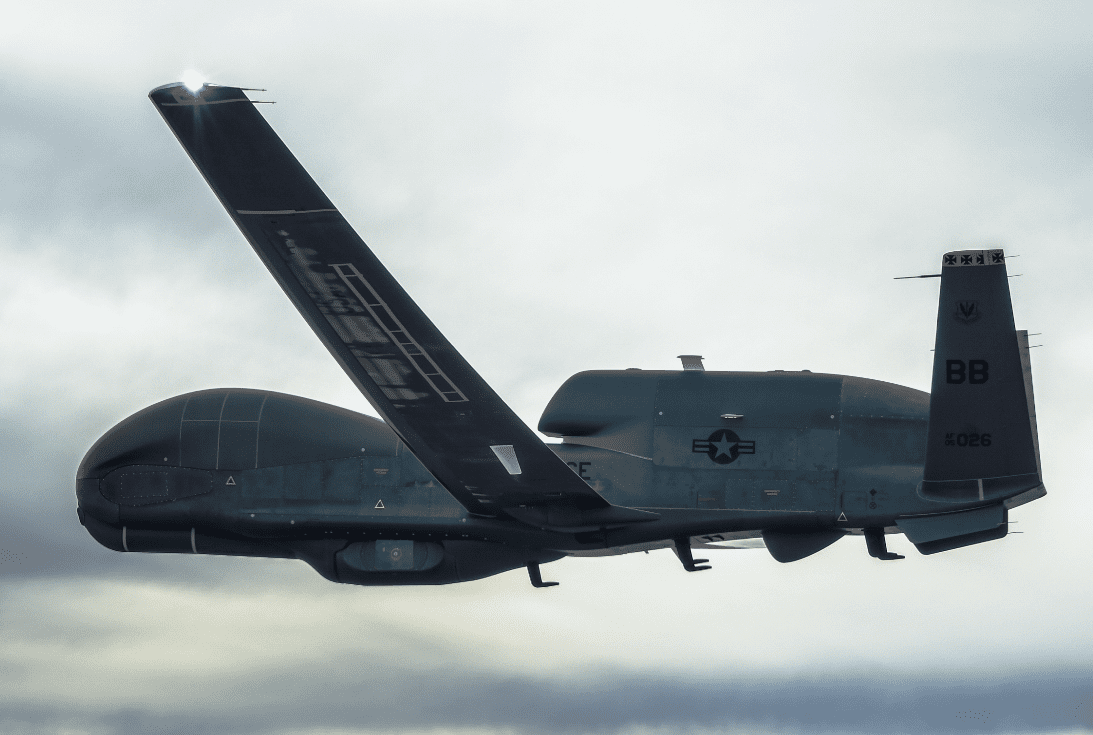
The Global Hawk received two new sensor updates advancing its imaging and electronic threat deterrence capabilities. (Northrop Grumman)
Northrop Grumman delivered two new sensors that will improve the Global Hawk’s intelligence collection, imaging, and threat deterrence capabilities. The new MS-177 multispectral camera system will provide long-range high-resolution imaging and the updated AN/ASQ-230 has added capabilities to mitigate electronic threats.
The MS-177, made by Collins Aerospace, is a new Senior Year Electro-optical Reconnaissance System (SYERS) sensor and is similar to what is currently used on the U-2S aircraft, according to Collins’ website. The MS-177 sensor will have the capability to pivot side to side and forward and backward where the SYERS-2, used on the U-2S, is only able to move from side to side. The added capability of the MS-177 enables new imaging capabilities.
Collins is working on an update to the MS-177, the MS-177A, which will use design elements of the SYERS-2A and DB-100 sensors, according to Collins’ website. The MS-177A will provide geolocation accuracy and persistent imaging enabling it to give analysts extensive target detection and tracking capabilities.
The AN/ASQ-230 sensor, made by Northrop, was updated to better support against electronic threats like radar, according to a Sept. 24 press release. Northrop describes the Global Hawk as a family of high altitude long endurance (HALE) drones that build on the common RQ-4 Global Hawk airframe.

The MS-177 sensor update for the Global Hawk will enable expanded imaging capabilities. (Northrop Grumman)
“The Airborne Signals Intelligence Payload (ASIP) sensor detects, identifies and locates radar and other types of electronic and modern communication signals,” Leslie Smith, vice president of Global Hawk at Northrop Grumman told Avionics International. “Fielding of the ASIP increment 1 enhances Global Hawk’s support against electronic threats and delivers additional signals intelligence capabilities to the warfighter.”
The Global Hawk, born out of the Defense Advanced Research Projects Agency (DARPA), is an unmanned aircraft system (UAS) capable of gathering information with its Enhanced Integrated Sensor Suite (EISS) that includes synthetic aperture radar (SAR) antenna, a ground moving target indicator (GMTI), a high-resolution electro-optical (EO) digital camera, and an infrared (IR) sensor.
A 2020 report published by the Center for Strategic and Budgetary Assessments states the need for non-stealthy long-endurance unmanned aircraft systems (UAS) to detect acts of aggression in the Western Pacific and Eastern Europe. In the report, the DoD classifies the Global Hawk most suitable for deterrence by detection missions because it is a high-altitude long-endurance (HALE) UAS.
“Ongoing improvements to Global Hawk underscore Northrop Grumman’s commitment to the United States Air Force’s ISR mission and reducing costs through agile development and leveraged solutions,” Smith said. “New and improved payloads flying on our young, yet proven fleet of aircraft will allow our partners to deploy high value, networked assets to monitor adversaries while not risking the lives of military personnel well into the 2040s.”